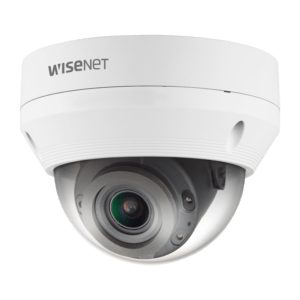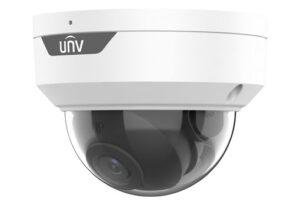overview
Dome CCTV cameras are a type of closed-circuit television (CCTV) camera that are typically used for indoor surveillance purposes. They are named after their dome-shaped housing, which protects the camera lens and makes it difficult for potential intruders to determine the camera’s field of view. Dome cameras are usually mounted on the ceiling and are often used in retail stores, banks, schools, and other public spaces. They come in various sizes, with some being very small and discreet, and others being larger and more noticeable. Dome cameras are often preferred for their attractive design, vandal-resistant housing, and ease of installation. Additionally, they are versatile and can be used in a variety of lighting conditions, as some models come with infrared night vision capabilities.

Dome cameras have several benefits, including:
Overall, dome cameras are a versatile and cost-effective option for indoor surveillance, and their discreet design and vandal-resistant housing make them ideal for use in public spaces.
overview
Bullet CCTV cameras are a type of closed-circuit television (CCTV) camera that get their name from their cylindrical shape, which resembles a bullet. They are often used for outdoor surveillance, as they are designed to withstand harsh weather conditions. Bullet cameras are typically mounted on walls or poles and can be used to monitor a specific area or provide a panoramic view of a space.

Bullet cameras have several benefits, including:
Overall, bullet cameras are a durable and cost-effective option for outdoor surveillance, and their long-range viewing capabilities and night vision capabilities make them ideal for monitoring large areas or capturing high-quality images in low-light environments.
overview
PTZ (pan, tilt, and zoom) cameras are a type of closed-circuit television (CCTV) camera that allow for remote control of the camera’s orientation and zoom. This type of camera is often used in large indoor or outdoor spaces where a comprehensive view of the area is needed. PTZ cameras can be controlled remotely to pan (left and right), tilt (up and down), and zoom in and out, allowing users to easily survey a large area from a single camera.

PTZ cameras have several benefits, including:
Overall, PTZ cameras are a versatile and cost-effective option for large indoor or outdoor spaces where a comprehensive view of the area is needed. Their remote control capabilities and advanced features make them ideal for use in a variety of surveillance and monitoring applications.
overview
Day/Night CCTV cameras are a type of closed-circuit television (CCTV) camera designed to provide clear video footage both during the day and at night. These cameras use infrared (IR) technology to capture images in low-light conditions and switch automatically to day mode when sufficient light is available.

Day/night cameras have several benefits, including:
Overall, Day/Night CCTV cameras are a versatile and cost-effective option for areas where lighting conditions may vary. Their ability to capture clear footage in both daylight and low-light conditions makes them ideal for use in a variety of surveillance and monitoring applications.
overview
Infrared/Night Vision CCTV cameras are a type of closed-circuit television (CCTV) camera that uses infrared (IR) technology to capture images in low-light or total darkness. These cameras are equipped with IR illuminators that emit invisible light in the IR spectrum, allowing them to capture clear images even in complete darkness.

Infrared/Night Vision cameras have several benefits, including:
Overall, Infrared/Night Vision CCTV cameras are an effective solution for areas where lighting is limited or non-existent. Their ability to capture clear images in low-light and complete darkness makes them ideal for use in a variety of surveillance and monitoring applications.
overview
Network/IP CCTV cameras are digital cameras that use the Internet Protocol (IP) to transmit video and audio over a network. Unlike traditional analog CCTV cameras, IP cameras use digital compression to transmit video over a network, allowing for higher-quality images and more flexible and scalable surveillance systems.

Network/IP CCTV cameras have several benefits, including:
Overall, Network/IP CCTV cameras offer a flexible and scalable solution for digital surveillance, with high-quality images and the ability to remotely access and manage the system. They are ideal for use in a variety of residential, commercial, and industrial settings.
overview
Wireless CCTV cameras are security cameras that transmit video and audio signals wirelessly, eliminating the need for physical cabling. They are designed to be easy to install and can be placed in a variety of locations without being restricted by the need for a power source or network cable.

Wireless CCTV cameras have several benefits, including:
Overall, wireless CCTV cameras offer a flexible and cost-effective solution for digital surveillance, with the ability to be placed in a variety of locations without being restricted by physical cabling. They are ideal for residential, commercial, and industrial applications where ease of installation and flexibility are important considerations.
overview
High Definition (HD) CCTV cameras are security cameras that capture and transmit video in high definition resolution, typically 720p or 1080p. They provide clearer, more detailed images compared to standard definition (SD) cameras, which have a lower resolution.

High Definition (HD) CCTV cameras have several benefits, including:
Overall, HD CCTV cameras provide improved image quality and increased situational awareness, making them ideal for applications where detail is important, such as in retail environments, schools, and government buildings. They are also ideal for use in residential and commercial environments, where the improved image quality can provide greater peace of mind and protection.
